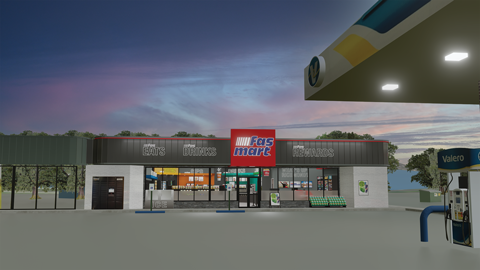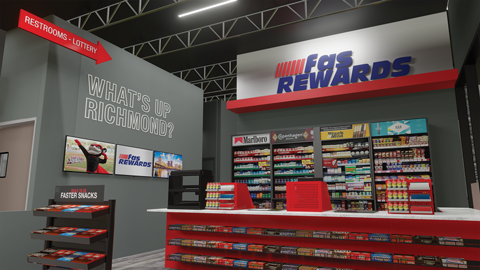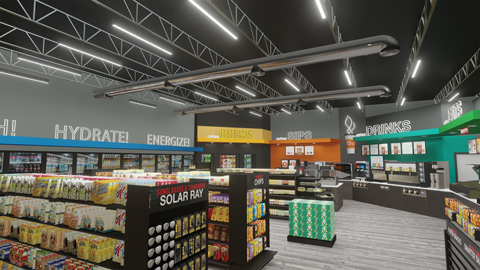After accelerating from 300 stores to close to 1,400 retail stores and 1,500 dealer sites in less than 10 years, GPM Investments LLC stood at a crossroads. “Our strategy for the last eight years has been acquiring stores through buying smaller regional chains,” said Michael Bloom, executive vice president and chief merchandising and marketing officer at GPM. “Our goal was to get to scale, and now that we’ve arrived at a level of scale, it’s time to go back and reinvest in our assets.”
That reinvestment coalesced into a single question: How could GPM tie together a bunch of regional brands into a cohesive unit without losing what made those brands special? “It’s no secret that we haven’t spent a lot of money in these stores,” Bloom said. “But now we’ve started remodeling and resetting these stores to maximize the customer experience.”
Every store will have the same base assortment of products, but each will have the ability to add regional favorites.
While the company originally had the first next-generation remodel scheduled for last summer, the coronavirus pandemic upended those plans. “We’re glad we held off, as in the interim, we learned a lot about how the consumer was changing their shopping behavior and the products they were purchasing,” he said. “They were buying larger sizes and making fewer trips, so we were able to tweak our prototype to deliver on the customer expectation and improve their experience.”
The Thought Process
With a portfolio of beloved regional chains, GPM had no intention of jettisoning the goodwill built up in those communities for years by wiping away individual store identities. “These family legacy brands like Village Pantry, Scotchman and E-Z Mart are very well-known,” Bloom said. “We wanted to keep the integrity of those brands because it’s important for the former owners, employees and customers. These are brands that customers have come to love, and it’s our responsibility to bring them up to date.”
About 18 months ago, GPM began working on a new prototype concept that would tie everything together yet allow its diverse suite of brands to shine. “The average life of a brand we’ve acquired is in the 50-year range,” Bloom said. “That’s a lot of brand equity we didn’t want to squander.”
To solve that potential problem, the company came up with an overarching theme for each store. One example is “fas EATS!” and “fas DRINKS!”. Each brand’s name still graces the redesigned entrance, but inside, customers see the bright, colorful signage with the same theme and wording.
The store design includes new forecourt canopies from fuel partner Valero and bright lights both outdoors and indoors. The inside remodel included opening up windows to brighten the stores. Each store also will boast a community wall to highlight local events both for the area and store.
Uniform Yet Unique
For a company-wide redesign to work, a level of uniformity had to be layered over each regional brand. “We took a hard look at everything and came up with a list of what each store had to have in terms of merchandising and categories,” Bloom said.



 GPM shared with NACS Magazine renderings by GSP of a new Fas Mart store in Richmond, Virginia, slated to open this spring. The exterior is modern, bright and welcoming, with large windows to let in natural light. Signage over the back bar touts the fas Rewards loyalty program, and an adjacent wall will highlight local community events. The new Richmond store will have foodservice space to prepare fresh pizza, salads, sandwiches and other foods. The entrance is designed for high-impact category placement, and signage is unified throughout the store. See video at www.vimeo.com/480813782. Renderings by GSP
GPM shared with NACS Magazine renderings by GSP of a new Fas Mart store in Richmond, Virginia, slated to open this spring. The exterior is modern, bright and welcoming, with large windows to let in natural light. Signage over the back bar touts the fas Rewards loyalty program, and an adjacent wall will highlight local community events. The new Richmond store will have foodservice space to prepare fresh pizza, salads, sandwiches and other foods. The entrance is designed for high-impact category placement, and signage is unified throughout the store. See video at www.vimeo.com/480813782. Renderings by GSP
For the prototype, GPM started from scratch with what today’s customer expects in a modern convenience store. “Delis with fresh food—that’s entry into the game today,” Bloom said, ticking off other important categories: frozen foods, grab and go, roller grills, beer caves and the right number of cooler doors (14 is the new minimum standard).
Many of the stores will have the ability to prepare fresh pizza, salads and sandwiches. All will get a new bean-to-cup coffee program. The company also targeted the back bar for the right mix of lottery, cigarettes and other tobacco products in a cleaner, branded look.
“Every store will have the same base assortment of products, but each will have select regional favorites,” Bloom said. For example, many areas have unique candy items that sell better in that market, so those stores will carry the local confection. “Internally, we developed a process to use regional information to develop regional planograms,” he said. “We’re not going to interfere with the integrity of the core base planogram because we built in the ability to add some local items into the master plan.”
The company plans on doing everything it can to avoid closing a location during the remodel, which aims to keep the same flow if possible. “Our stores average 1,500 to 3,000 square feet, so there’s not a lot of room to maneuver,” he said. “If it makes sense to leave things like checkout in the same place after the remodel, then we will. But the redesign also gives us a chance to correct layouts to improve the customer experience.”
Overall, the company hopes that having the same look and feel inside stores across different brands will clue in customers that the brands are connected. “We want our customers to know they will get the same great experience in a Scotchman as in a fas mart,” Bloom said.
Overcoming Challenges
As with many companies, the COVID-19 pandemic upended some of GPM’s reboot plans. “We don’t build our stores from scratch—we’re working with existing footprints for the most part,” Bloom said. That meant when GPM realized stores needed more freezer space because frozen foods sales skyrocketed, it was challenging to add freezers into the plans.
“Freezers jumped to the top of the list of things we needed to adjust because of the pandemic,” he said. “We had freezers in very few stores, and we couldn’t keep items like frozen pizzas in stock.”
While freezers will be in every store as part of the remodel, GPM worked to add them to as many stores as it could over the summer. “The biggest challenge was actually getting the freezers, but once we figured that out, we’ve added a nice assortment of frozen foods, including frozen dinners, French fries, frozen burgers and six to eight different brands of frozen pizza,” he said. Currently, about 200 stores have freezers, and approximately 800 stores will have them in 2021.
The pandemic also accelerated the sale of take-home beer. “The sale of 12-, 18- and 24-packs of beer is off the charts,” Bloom said. To meet that need, GPM enlarged its display space in stores where it could and made sure many remodels will have a beer cave. “We don’t see this stopping. We think people will change their behavior, continue to work from home more, make fewer trips and buy more,” he said. “What better retailer than a convenience store close to home for cold beer, snacks, candy and more?”
GPM also became an early adopter of carrying face masks and hand sanitizer. “We sold our first mask at the end of March/early April last year when other retailers didn’t have them,” Bloom said. “We think these products are both impulse and planned purchases, so we consider them essential products to have in stock all year round.”
Customer Connection
During the planning stages, GPM based much of its decisions on data. “We’re a data-based customer decision-making company,” Bloom said. Data sources include Spectra, IRI, NielsenIQ and NACS for geographic, demographic, trips and market share for grocery, convenience stores and dollar stores.
“Mining that data taught us about frozen food,” he pointed out. “When we looked across the data points and found out how much new business was in frozen pizza, for example, we were able to tap into manufacturers and suppliers as close to the front of the trend as possible.”
“Over the past few months, we have had the opportunity to take learnings from our customers’ shopping behaviors as well as the changing consumer environment and implement key updates to our remodel program and in-store offering to provide an enhanced customer experience emphasizing the local regional brand,” said Arie Kotler, president and CEO of GPM and its parent company, ARKO Corp.
Ahead of the remodel, the company relaunched its customer loyalty program in early November. “We refer to it as a customer relationship marketing program with loyalty as the outcome,” Bloom said. “The more we communicate with our customers and understand them, the more loyal they become.”
The new fas Rewards platform run by Paytronix provides both nurturing and value offerings for enrolled members. “We know who they are and what’s important to them, with a ‘your way’ points redemption part,” he said. The relaunch also ties all of the store brands under one umbrella, so customers can acquire points at one brand and use them at another.
As GPM presses forward with remodel plans, Kotler said the company would continue to acquire stores. “Our remodel team and our acquisition team work independently and will continue to do so into the future,” Kotler said. “We’re not going to slow down because this is our growth story—buying brands with history and equity and making them part of our larger family. We think of ourselves as ‘A Family of Community Brands.’”